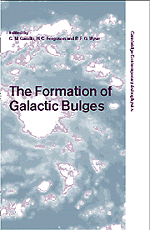Book contents
- Frontmatter
- Contents
- Preface
- Dedication: In Memory of Olin Eggen
- Part 1 Introduction
- Part 2 The Epoch of Bulge Formation
- Part 3 The Timescales of Bulge Formation
- Part 4 Physical Processes in Bulge Formation
- The Role of Bars for Secular Bulge Formation
- Bars and Boxy/Peanut-Shaped Bulges: An Observational Point of View
- Boxy- and Peanut-Shaped Bulges
- A New Class of Bulges
- The Role of Secondary Bars in Bulge Formation
- Radial Transport of Molecular Gas to the Nuclei of Spiral Galaxies
- Dynamical Evolution of Bulge Shapes
- Two-Component Stellar Systems: Phase-Space Constraints
- Central NGC 2146 – A Firehose-Type Bending Instability?
- Bulge Formation: The Role of the Multi-Phase ISM
- Global Evolution of a Self-Gravitating Multi-Phase ISM in the Central Kpc Region of Galaxies
- Part 5 Bulge Phenomenology
- Part 6 Conference Summary
- Index
Central NGC 2146 – A Firehose-Type Bending Instability?
from Part 4 - Physical Processes in Bulge Formation
Published online by Cambridge University Press: 10 November 2010
- Frontmatter
- Contents
- Preface
- Dedication: In Memory of Olin Eggen
- Part 1 Introduction
- Part 2 The Epoch of Bulge Formation
- Part 3 The Timescales of Bulge Formation
- Part 4 Physical Processes in Bulge Formation
- The Role of Bars for Secular Bulge Formation
- Bars and Boxy/Peanut-Shaped Bulges: An Observational Point of View
- Boxy- and Peanut-Shaped Bulges
- A New Class of Bulges
- The Role of Secondary Bars in Bulge Formation
- Radial Transport of Molecular Gas to the Nuclei of Spiral Galaxies
- Dynamical Evolution of Bulge Shapes
- Two-Component Stellar Systems: Phase-Space Constraints
- Central NGC 2146 – A Firehose-Type Bending Instability?
- Bulge Formation: The Role of the Multi-Phase ISM
- Global Evolution of a Self-Gravitating Multi-Phase ISM in the Central Kpc Region of Galaxies
- Part 5 Bulge Phenomenology
- Part 6 Conference Summary
- Index
Summary
The ‘firehose’ instability in central disks is discussed. This instability may arise in the centers of galaxies where the stars move in thin, practically non-rotating disks. N-body simulations described here predict the existence of a new type of structure – small-scale ∼ h out-of-plane bends of newly formed OB stars – in the central regions of spiral galaxies with high star formation rates.
Introduction
As shown by gravitational N-body simulations and observations of highly flattened giant galaxies including the Milky Way, the central parts of these systems at distances of, say, r ≲ 0.7-1 kpc from the center rotate slowly, and their local circular velocities of regular galactic rotation become less than (or comparable to) the residual (random) velocities. In such a thin, practically nonrotating (‘pressure-supported’) central disk, a typical star moves along the bending, perpendicular to the equatorial plane layer, under the action of two forces which act in opposite directions: the destabilizing centrifugal force, Fc, and the restoring gravitational attraction, Fg. Obviously, fierce instabilities of the buckling kind developing perpendicular to the plane may not be avoided if Fc > Fg. The latter condition is nothing else than the well-known condition of the so-called firehose electromagnetic instability in collisionless plasmas. The source of free energy in the instability is the intrinsic anisotropy of a velocity dispersion (‘temperature’).
- Type
- Chapter
- Information
- The Formation of Galactic Bulges , pp. 144 - 147Publisher: Cambridge University PressPrint publication year: 2000



